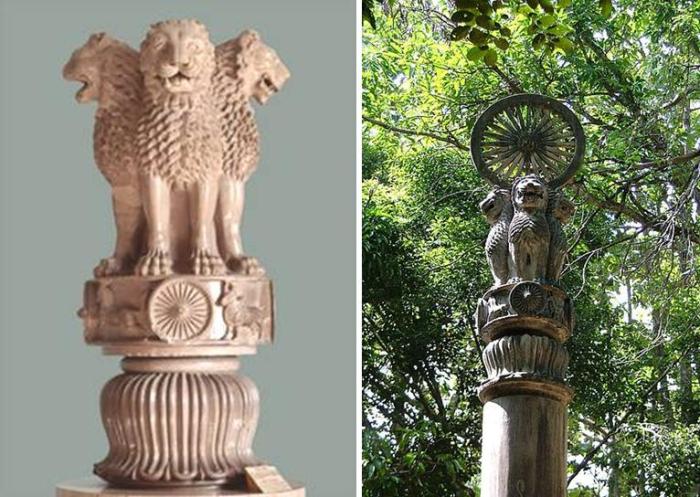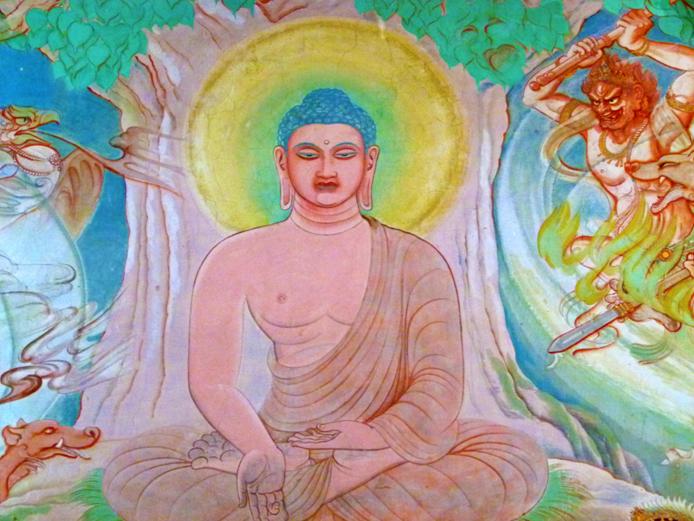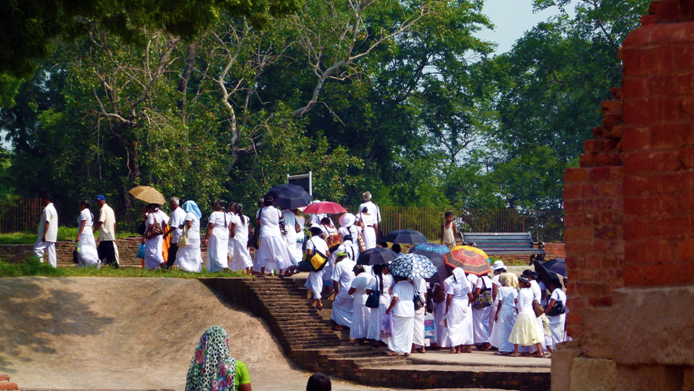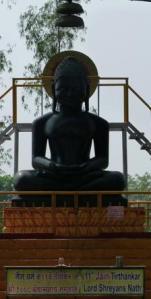 “What do you know about Sarnath?” Premkumar, the guide, asked me.
“What do you know about Sarnath?” Premkumar, the guide, asked me.
“Er… not much. Just school book stuff really. The Ashoka pillar, Buddha…,” my voice trails off in considerable embarrassment.
“ItisaholyplacefortheBuddhists,” I blurt out in a rush.
“Hmm…,” said the guide, eyeing me in much the same way that a teacher may look at a rather stupid student. “Well, then, let’s begin !
Sarnath has the same importance for Buddhists, as Mecca has for the Muslims or the Golden Temple in Amritsar has for the Sikhs. Sarnath is, perhaps, the most significant of all Buddhist holy places, as it is the place where the Buddha delivered his first sermon, thereby bestowing upon Sarnath the title of “birthplace of Buddhism”. In Pali, Sarnath was known as Isipatana, while in Sanskrit it was known as Rishipattana Mrigadava. Though not much is known about Sarnath before the arrival of the Buddha there, one can safely assume from the sculptures and inscriptions found in the area (and which are now housed in the local on site archaeological museum) that it was predominantly Hindu.
After his enlightenment in Bodh Gaya at 528 BCE, the Buddha travelled to Sarnath to meet his 5 companions (Koudanna, Vappa, Bhaddiya, Mahanama and Asvajita) as he wanted to share his new knowledge with them first. The place where the Buddha first met his 5 companions in Sarnath is now the site of the Chaukhandi Stupa.

The Chaukhandi Stupa is a brick structure crowned with an octagonal tower. According to Hiuen-Tsang’s accounts, this was the tallest stupa at that time in the area. It was destroyed and re-built sometime in the 5th century. The octagonal tower is a later addition, built by the Mughal Emperor Akbar in 1588, to commemorate the refuge given to Humayun in Sarnath, when he was on the run from Shershah Suri.
The Buddha gave the first discourse of his Dhamma and the eight-fold path at a deer park in Sarnath. That spot is marked by the Dhammeka Stupa, a solid, cylindrical, brick structure, 43.6 m high and 28 m in diameter. The original foundations laid by the Emperor Ashoka in 249 BCE are still intact, though the stupa itself was re-built in the 5th century and has seen modifications and additions from time to time.
According to an inscription recovered from this site and dated 1026 CE, this was known as the Dharma Chakra Stupa, which over the years changed to its present name. There are 8 niches facing 8 directions, which must have contained images of the Buddha. Below the niches runs a broad band of a beautifully carved designs including geometrical patterns, flowers, leaves, animals, human figures, swastikas, etc.


A short distance from the Dhammeka Stupa lie the remains of the Dharmarajika Stupa, believed to have contained the bones of the Buddha. Constructed by Emperor Ashoka, this stupa is believed to have been destroyed by one Jagat Singh, the Devan of Varanasi, in 1794 to obtain bricks for construction. During demolition of the Stupa, a casket containing bones and gems were recovered. While the bones were disposed off in the Ganga on Jagat Singh’s orders, the gems have remained untraceable till date. However, the casket is now on display at the Indian Museum in Kolkata.

According to inscriptions, there has always been a community of Buddhist monks in Sarnath from 200 BCE onwards. Sarnath achieved great heights during the Ashoka (273-232 BCE) and Gupta (400-600 CE) periods, with the latter period seeing an explosion in the spread of Buddhism as well as creativity in the arts. Nearly 3,000 monks used to live in monasteries near the Dhammeka Stupa during the Gupta period. Today, the original monastery is no longer standing and only its ruins remain.

 In the midst of all the ruins, there is a fenced-in structure containing what look like broken cylinders with inscriptions on them. These are the remnants of the Ashoka Pillar of Sarnath.
In the midst of all the ruins, there is a fenced-in structure containing what look like broken cylinders with inscriptions on them. These are the remnants of the Ashoka Pillar of Sarnath.
Ashoka built a series of pillars throughout the northern Indian subcontinent, and the Ashoka Pillar in Sarnath is perhaps the grandest of them all. In its original form it would have been 12.25 m high, and capped by a Lion Capital. A dharmachakra or what is commonly known as the Ashoka Chakra, topped this edifice. At least that is what it would have looked like if the pillar had not been broken during invasions by the Turks
The  Ashoka Pillar and the Lion Capital were discovered in Sarnath during excavations in 1904. Fragments of the dharmachakra were found around the pillar, which had 3 sets of inscriptions.
Ashoka Pillar and the Lion Capital were discovered in Sarnath during excavations in 1904. Fragments of the dharmachakra were found around the pillar, which had 3 sets of inscriptions.
Today the Lion Capital occupies pride of place at the local Sarnath Archaeological Museum. The wheel fragments have been mounted on the walls of the museum in an attempt at reconstruction. See the photograph below. On the left is the Lion Capital of Sarnath as seen in the Sarnath Museum, and on the right is a photograph of a Ashoka Pillar in Thailand, capped with a lion capital and topped with the dharmachakra.

The Sarnath Archaeological Museum is an on site museum and one of the best museums I have been to. It is a treasure trove of awe-inspiring Buddhist art as well as many images and sculptures of Hindu Gods collected during excavations in the area. Some of the more stunning artefacts include a life-sized image of a standing Bodhisattva, a panel depicting Shiva slaying Andhakasura, and of course the Lion Capital. Unfortunately, photography is not permitted inside the museum and I could not take a single one there. I was particularly disappointed about not being able to take a picture of the Lion Capital, which is the national emblem of India.
There are many Buddhist temples built by various countries in Sarnath, with each one of them reflecting the architectural style of that country. One of the more well-known ones, and the only one that I was able to visit, is the Mulagandhakuti Vihara built by the Sri Lankan Mahabodhi Society.


This temple was built in 1931 and enshrines Buddha’s relics found in Taxila, and which are displayed every year on Karthik Purnima. The walls of this temple have frescoes depicting the life of the Buddha, which were done over a 3 years from 1932-1935 by a Japanese artist, called Kosetu Nasu.


A short distance away from the Vihara is the holy Bodhivriksha, which was grown from the branch brought to Sarnath from Sri Lanka by Sanghamitra, Ashoka’s daughter. Surrounding the Bodhivriksha are 28 small statues of various Buddhist saints.

The other important places associated with the life of the Buddha in India are Lumbini (his birthplace), Bodh Gaya (where he attained enlightenment), and Kusinagar (where he attained parinirvana). But Sarnath is perhaps the most important of these four places, and has developed into a major international tourist spot today. During my visit to Sarnath, I saw very few Indians there. But there were Buddhist monks, as well as regular tourists from all over the world.

After the guided tour, I spend a wonderful morning in Sarnath among the ruins trying to understand all that the guide has told me, and by reading a book on Sarnath (written by Shanti Swarup Baudh titled Sarnath: The Great Holy Place of the Buddhists) that I purchased at the Mulagandhakuti Vihara.
I go back to the Dhammeka Stupa to see the delicate and beautiful designs. I am drawn by the peace that envelops the site with the visiting monks, nuns and tourists from all over the world sitting around the stupa meditating or praying. It is so quiet that I become aware of my breathing and sit down to meditate and pray.
 As I leave the ruins of the monastery, I notice a large, black statue some distance away. Thinking it to be a statue of the Buddha, I wonder why the guide has not pointed it out to me. When I reach the site, I discover that it is not a Buddha statue, but that of Lord Shreyasnath, the 11th Jain Tirthankara. I discover then that Sarnath is holy for the Jains as well as it is the birthplace of Shreyasnath.
As I leave the ruins of the monastery, I notice a large, black statue some distance away. Thinking it to be a statue of the Buddha, I wonder why the guide has not pointed it out to me. When I reach the site, I discover that it is not a Buddha statue, but that of Lord Shreyasnath, the 11th Jain Tirthankara. I discover then that Sarnath is holy for the Jains as well as it is the birthplace of Shreyasnath.
I got talking with a group of Jain pilgrims there, who told me that because of the pre-eminence given to the Buddha and Buddhism in Sarnath, not many people were aware of its association with Jainism. They invited me to go with them to a nearby Jain temple, which I gladly accepted.
Sarnath is just 8 km from Varanasi. Both are holy sites for Buddhism (and Jainism) and Hinduism, respectively. Both places are hot, dusty and filled with tourists. Both are ancient cities, deeply spiritual and associated with the divine, in a way that is difficult to put down in words. But that’s where the similarity ends. And, I couldn’t help, but ponder over their vastly differing outer manifestations. While Varanasi is loud and noisy even, Sarnath is calm and serene. Yet, both of them have been deeply enriching visits for me.
I came to Sarnath with absolutely no knowledge about Buddhism (or Jainism for that matter), apart from almost forgotten school history book level information. I left Sarnath a little more knowledgeable about Buddhism (and Jainism), and with absolute knowledge of how much I do not know.
But that that is what travel is all about, isn’t it?

मैं यहाँ एक बार जा चुका हूँ बहुत ही अच्छी जगह है जहाँ पर हमारे भूतकाल को अच्छी तरह सुरक्षित बचाया हुआ है।
LikeLike
Sarnath is really beautiful and very well maintained.
LikeLike
See, there’s a good reason I stalk your blog. I have learnt so much about Sarnath and my bucket list of places to visit grows longer. Thank you for the wonderful post and the great pictures 🙂
LikeLike
Sarnath was like a school history text book come alive and then some more. It should be on the must visit list of all, according to me.
And I like this type of stalking. Very Much. So do keep stalking. 🙂
LikeLike
That was a wonderful photo essay, informative and interesting. I have visited Bodh Gaya and Sanchi but not Sarnath. Even in Gaya, all Buddhist countries have their own temples and you can see their distinctive styles of architecture. The Japanese and Sri Lankans play an important role in maintaining the monuments in Sanchi.
Both Buddhism and Jainism are structured religions which had been founded (??) by masters. That’s one of the chief reasons for the difference between the Varanasi and Sarnath as Hinduism is just the way of life of a people and that has to be enjoyed/endured in all its various colours, sights and sounds 😀
LikeLike
And I have visited only Sarnath and look forward to visiting the other places in the near future. 🙂
My observation about the contrast/differences between Sarnath and Varanasi is not about which one is better or even the reasons. Because both are holy places which evoked similar feelings in me in spite of the contrast.
Thank you so much for your ever-encouraging comments, Zephyr.
LikeLike
I remember the place vaguely from the history books we learnt at school. Thanks for putting a picture to all those learning. 🙂
LikeLike
Then it is time that you also visit Sarnath to bring textbook memories to life 🙂
LikeLike
Have visited SANCHI but this looks very intresting will remember for my future travel itenary. THANKS
LikeLike
Sarnath is definitely a must-visit, Arnavaz. Maybe, you could combine it with other Buddhist piligrimage centres and make it a Buddhist tour 🙂
LikeLike
wonderfully illustrated and comprehensive
LikeLike
Thank you, Magiceye. So glad that you liked it.
LikeLike
really beautiful!!
LikeLike
Welcome here, Geet, and thank you so much for stopping by and commenting. I do hope that you will keep visiting.
LikeLike
A dream destination now.
Fantastic pictures.
LikeLike
It is a wonderful place to visit and the enormity of its importance hits you only when you are actually there.
Thanks for stopping by and commenting. Indrani. Much appreciated 🙂
LikeLike
You seem to be on the road all the time 🙂
Love to read your travel posts and enjoy the pictures.
LikeLiked by 1 person
I wish i would be on the road all the time, well at least most of time. 🙂 This was a 10 day break and i travelled to different parts of UP.
LikeLike
I visited Sarnath with my friends when we were in Class 12th. Dunno about them, but I loved the place ! In those days we had no camera and little knowledge of this place. Now when I see it through your pics, I feel Nostalgic! This is where my Buddha Trail will take me next, maybe in my next visit. 🙂
BTW don’t you think your blog is getting monotonous? Great posts and beautiful pics is getting so predictable in your case. Try writing a mediocre one for a change 😛
LikeLike
And my Buddha trail will hopefully lead me to Bodh Gaya, which you have visited. 🙂
You may be right, about the blog getting monotonous. And I must listen to what my readers say, shouldn’t I? I’ll try to oblige. 😛
LikeLike
lovely post! ive been to sarnath twice, and neither time could i take a guide… the first time i was with my grandfather who grumbled about having to come and see some old decrepit places which werent even temples, though he was impressed about it being the place where Buddha delivered his first sermon.. the second time i arrived at a time when the guides had all gone off! and the museum happened to be closed that day, so i missed that too! guess this indicates yet another visit to the place! and one i would welcome.. its such a nice and peaceful place u can almost understand why Buddha would have come here!
LikeLike
Sarnath is so serene and calm that after the hustle and bustle of Varanasi it comes as a shock. A guide is good, but with a good book on Sarnath (I purchased mine in the Mulagandhakuti Vihara) and the signposted monuments one can get by without a guide.
LikeLike
A wonderful,informative,and lovely post!!!!!
LikeLike
Thank you, Neeraj 🙂 Have you visited Sarnath?
LikeLike
Excellent write up… so much detail…
Need to visit it sometime…
LikeLike
Welcome here Jitaditya and thank you so much for stopping by and commenting.Glad you liked it and I hope that you get to visit Sarnath soon 🙂
LikeLike
My first impression while reading this articles was “What!!”
The title was little misunderstanding but I agree with the title. Sarnath is indeed the birthplace of Buddhism. First Sermon taught by Lord Buddha to Kaundinya and other four disicples started the Buddhism.
LikeLike
Welcome here, Antique Buddhas. Thank you for stopping by and commenting. Keep visiting.
LikeLike